
Complimentary branded calendar for the year 1969, handed out to General Petroleum employees. A table of selling prices for petrol per litre at service and supply stations in Egypt is on the reverse.
Slightly creased and spotted. Enclosed is a print company logo on a small rectangular sheet (unevenly cut, ca. 97 x 104 mm).
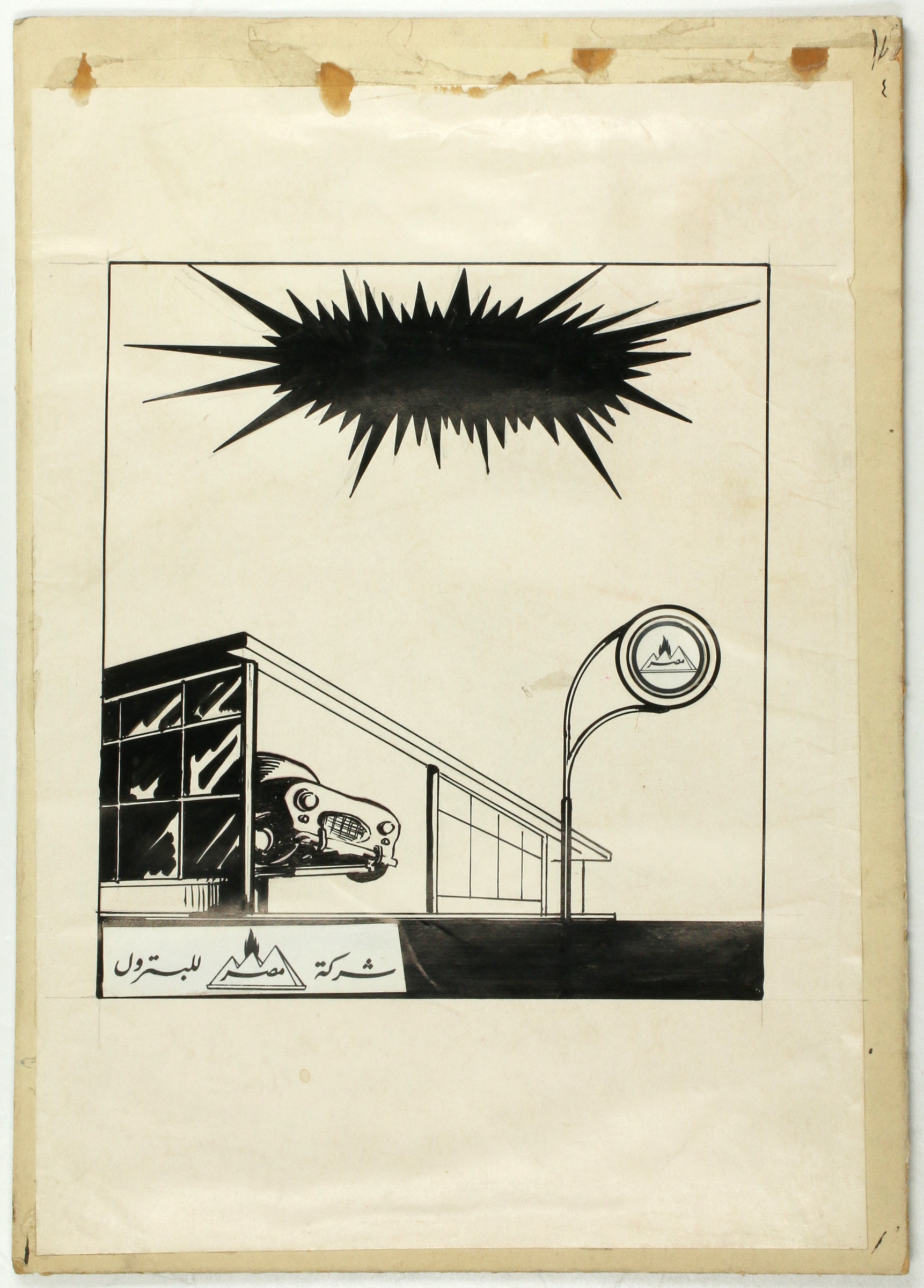
Unique drawing of a General Petroleum service station, featuring a car on a hydraulic lift and a coporate signpost on the street. With 2 company logos cut out from a magazine and pasted to the signpost and to the lower left corner of the drawing. A jagged element resembling an oil blot in the otherwise blank part above the service station was presumably intended for a caption but lacks any lettering, suggesting that the drawing was left unfinished.
A little creased. Backing cardboard somewhat worn with fragments of handwritten Arabic script in blue and green on the reverse.

Educational brochure on company endeavours, describing the leading role of General Petroleum as supplier of fuels for heavy industry and agriculture, as well as various kinds of transportation and their clientele, including international shipping lines frequenting the ports of Egypt. In addition, the company produces a variety of petrochemicals, including pesticides, insecticides, and detergents for both agricultural and domestic use.
Very well preserved.

First edition of Fiamelli's work on military fortifications, extensively illustrated with woodcut diagrams. A Florentine mathematician and engineer who worked for the Duke of Parma in the Low Countries, Giovanni Fiammelli (1565-1614) was particularly interested not only in the engineering of these monumental Renaissance defenses, but also in debating the pros and cons of military fortifications in different defensive positions and battle plans. This stemmed in part from an older debate stirred up by the likes of Niccolò Machiavelli, whose writings a generation earlier discussed the varying usefulness of fortifications for a ruler. Machiavelli had suggested that extensive fortifications were useful only when the ruler of an Italian principality feared uprisings from their own people, but were not a particular advantage for foreign invasions; he stressed fortifications around cities rather than personal castles, and winning the loyalty (or at least lack of hatred) of the populace.
In "Il principe difeso", Fiammelli uses his greater engineering knowledge to design and examine the strengths and weaknesses of fortifications. He holds that good ones are useful, but that they have to be used competently in order to be effective. This is one of several military works that Fiammelli wrote while resident in Rome at the end of his life.

Original press photograph of the Palestinian delegation to the 1939 London Conference, meeting with Prime Minister Chamberlain and other British officials in St. James's Palace. The conference was called by the British Government to plan the future governance of Palestine and an end of the Mandate. It took place between 7 February and 17 March 1939.
The photograph shows the Palestinian delegates sitting in the foreground, including Jamal Al-Husseini, Amim Tamimi, Fuad Saba, Yaqub Al-Ghussein, Musa Alami, Awni Abdul Hadi, George Antonious, and Alfred Roch. Facing are the British, with Neville Chamberlain presiding. To his right is Lord Halifax, and to his left, Colonial Secretary Malcolm MacDonald. Famously, MacDonald held a series of separate meetings with the Palestinian and Zionist delegations, because the Palestinian delegation refused to sit in the same room as the Zionists, a circumstance also indicated by the caption on the photograph: "Meetings have to be in two sections since Arabs refuse to meet in same room with their Jewish rivals".
Coming to an end after five and a half weeks, the conference remained inconclusive, the British announcing proposals which were later published as the 1939 White Paper.
Corners slightly creased; one small tear to lower margin, not affecting image.

The original manuscript of one of the most famous novels of the 20th century. After having been rejected by the literary monthly Novy Mir for not adhering to socialist realism, the manuscript was smuggled out of Soviet Russia by the Italian journalist Sergio d'Angelo and first published by Feltrinelli in Italy in 1957. It became an international sensation, and numerous translations appeared almost immediately. John Maury, chief of the CIA's Soviet Russia division, recognized the novel as "the most heretical literary work by a Soviet author since Stalin's death". Perhaps the novel's greatest champion in America was the critic Edmund Wilson, who in The New Yorker described it as "one of the very great books of our time [...] a great act of faith in art and in the human spirit". Pasternak was denounced in Russia as being "anti-Soviet", and the pressure only increased after he was named winner of the Nobel Prize for Literature in 1958, which he was forced to refuse.
The present manuscript covers about a third of the entire novel. It is not only the most extensive Pasternak manuscript ever to have come to the market, but is also to be considered possibly the most important and iconic literary manuscript of the 20th century still in private possession.
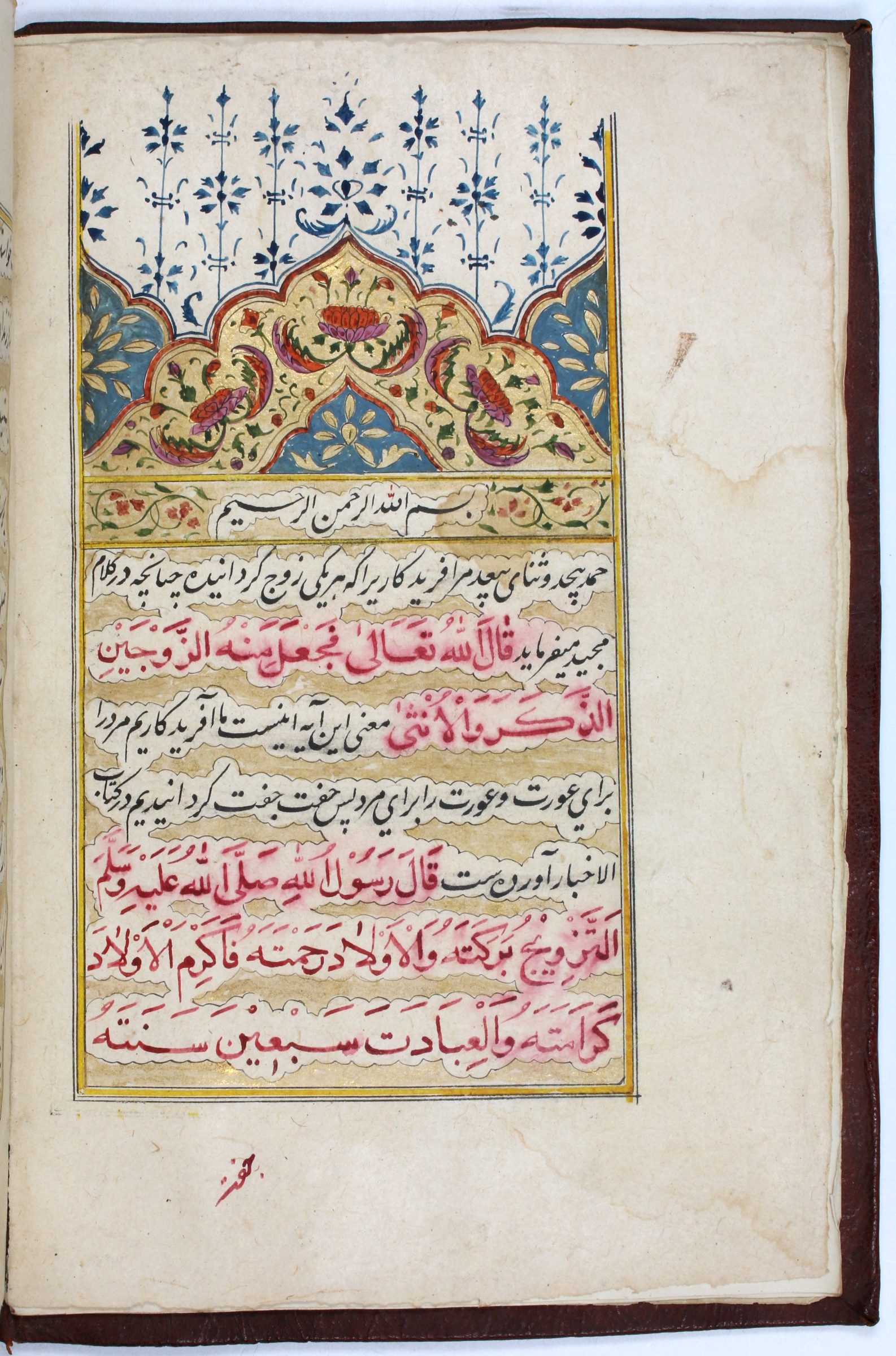
A Persian manuscript of "Lazzat Un Nisa", a famous erotic text derived and translated from the Sanskrit Kama Sutra, here featuring 30 explicit and educational miniatures, and bound with a manuscript translation of the same into English.
Drawing on the Sanskrit text, there are two separate textual traditions of "Lazzat Un Nisa" in Persian: one earlier 15th or 17th century translation from the Golden Age of erotic literature in the subcontinent, and another by Mohammed Abdul Mehdune, in 1850. Remarkably, the accompanying English translation significantly predates Richard Burton's notorious translation of the Kama Sutra, which Burton privately printed in 1883. The work is also notable, though not unique, for including one painting depicting homosexual intercourse between two men.
Popular from the 16th century onwards and a source of interest to European (and especially British) collectors, illustrated erotic manuscripts such as "Lazzat Un Nisa" have a robust history in the Indian subcontinent. Two English ownership inscriptions begin the volume, both probably by the same hand and expressing roughly the same sentiment. The first reads, "I procured this book in order to give an idea of the absurd and whimsical ideas of the Moors. The English is a literal translation of the Persian". The second, more formal attempt reads, "These Pictures were procured to give some Idea of the absurd & redicolous [sic] notions & practices of the Mahometans in India". Though their owner was scandalized, painted sexual manuals were popular and not uncommon; this example is, however, quite unusual in its inclusion of relatively good English translation of the text, including detailed and graphic passages with references to the rules of sex, marriage, and sexuality in the Qur'an, pregnancy, beauty, sensuality, "the flavour of her body", "species of women", and "the critical moment" of orgasm.
An early English translation from the Kama Sutra tradition.
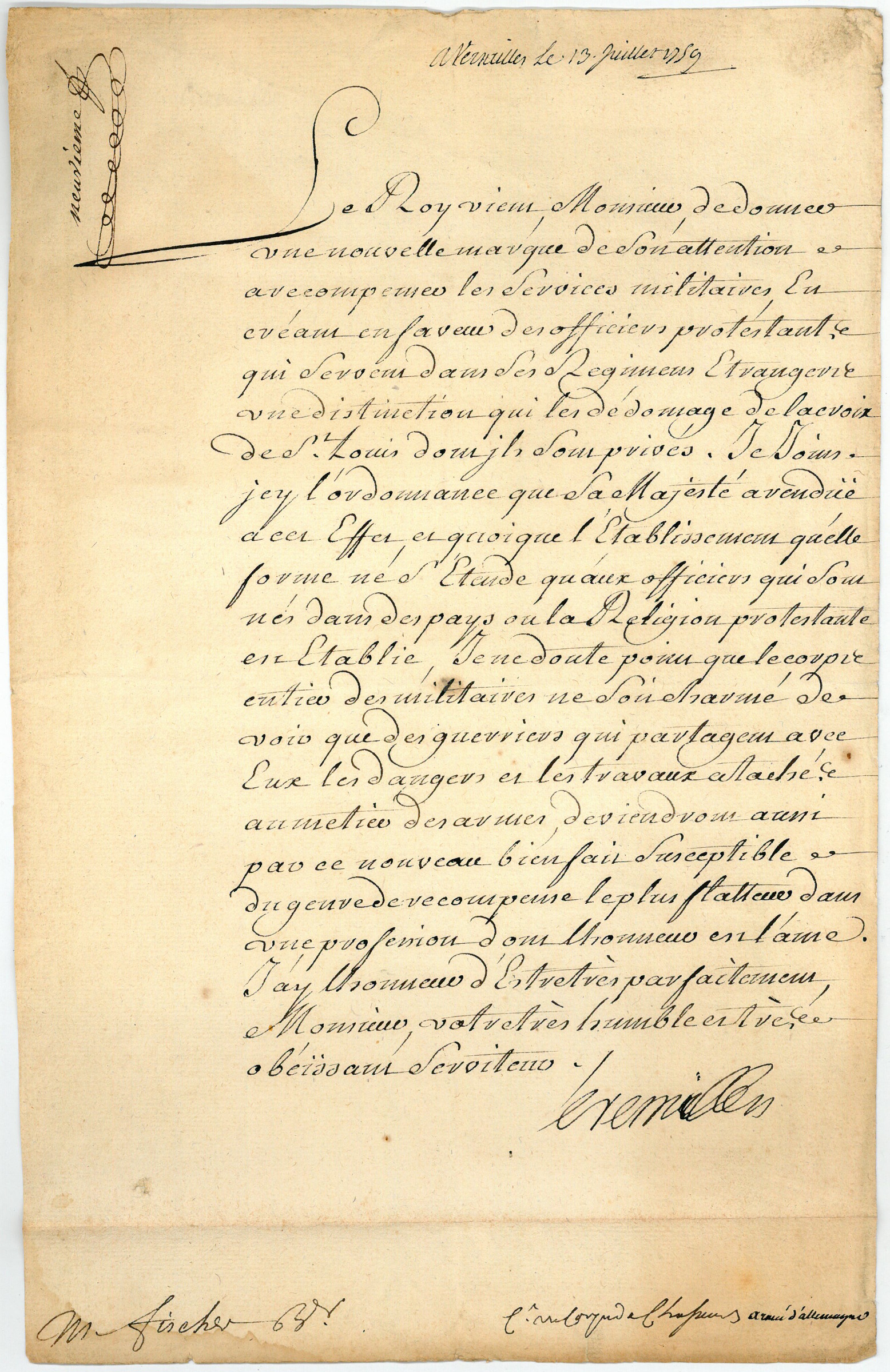
Highly interesting letter concerning the establishment of the Institution du Mérite militaire, a French military order that was created on 10 March 1759 by King Louis XV for foreign-born, non-Catholic military officers in French service. The letter is addressed to Johann Christian Fischer (1713-62), a German officer who led mostly German mercenaries in French service, so-called Volontaires Étrangers, since the 1742 Siege of Prague during the War of the Austrian Succession. In 1743 Fischer was authorized to raise a company of light cavalry and infantry that came to be known as the "Chasseurs de Fischer". The company fought in the War of the Austrian Succession and the Seven Years' War and was dissolved in 1776, being largely incorporated to the hussar regiment of Louis Gabriel Marquis de Conflans.
Boyer de Cremilles, who served in the war ministry under Charles Louis Auguste Fouquet de Belle-Isle, was delighted to inform Fischer of the new Order of Merit and originally attached a copy of the royal ordinance issued for its creation. As Protestants were excluded from the Order of Saint Louis, this new honour was supposed to offer them "compensation", and although it was reserved for foreigners in French service, he was convinced that the "entire military corps will be delighted" and that it would bolster general morale.
Minor browning.
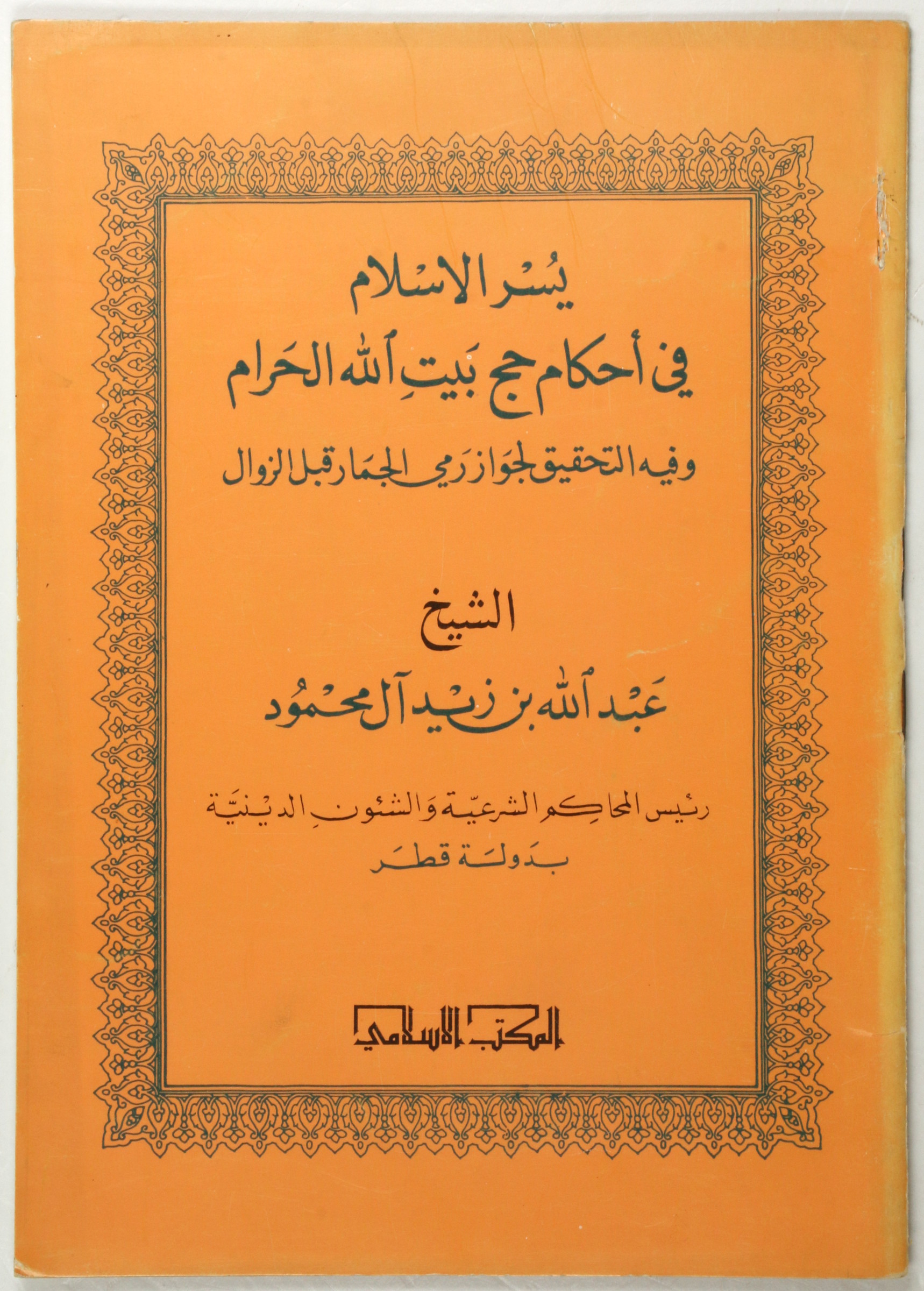
Rare publication by Sheikh Abdullah bin Zaid al Mahmoud of Qatar: essentially, an official guidebook comprising the basic rules of Hajj, including provisions for the stoning ritual as well as a permission for menstruating women to circumambulate the Kaaba.
One staple removed. In very good condition.
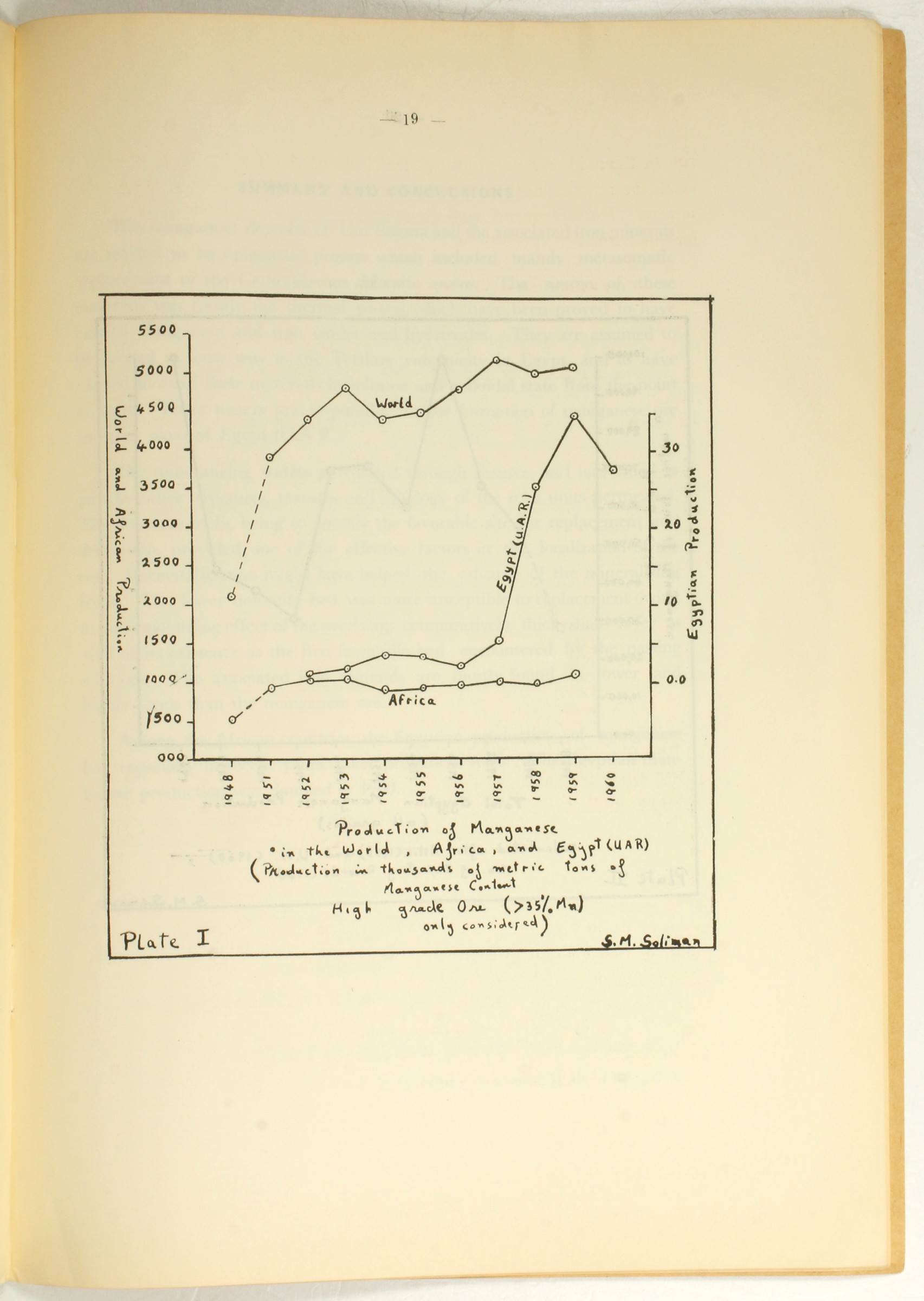
Scarce geological paper on manganese ores prepared by Dr. Soliman Mahmoud Soliman, professor of Geology at Ain Shams University in Cairo, who published prolifically on topics related to oil prospecting. Presented at the First Congress of Iron and Steel held from 6 to 9 November 1961. The paper investigates the evolution and structure of manganese ore deposits in Um Bogma on the Sinai Peninsula and the Egyptian production of manganese in general, arguing that the latter "has taken wide steps in recent years".
In excellent condition. Only a single library copy traceable worldwide, held at Yale University.
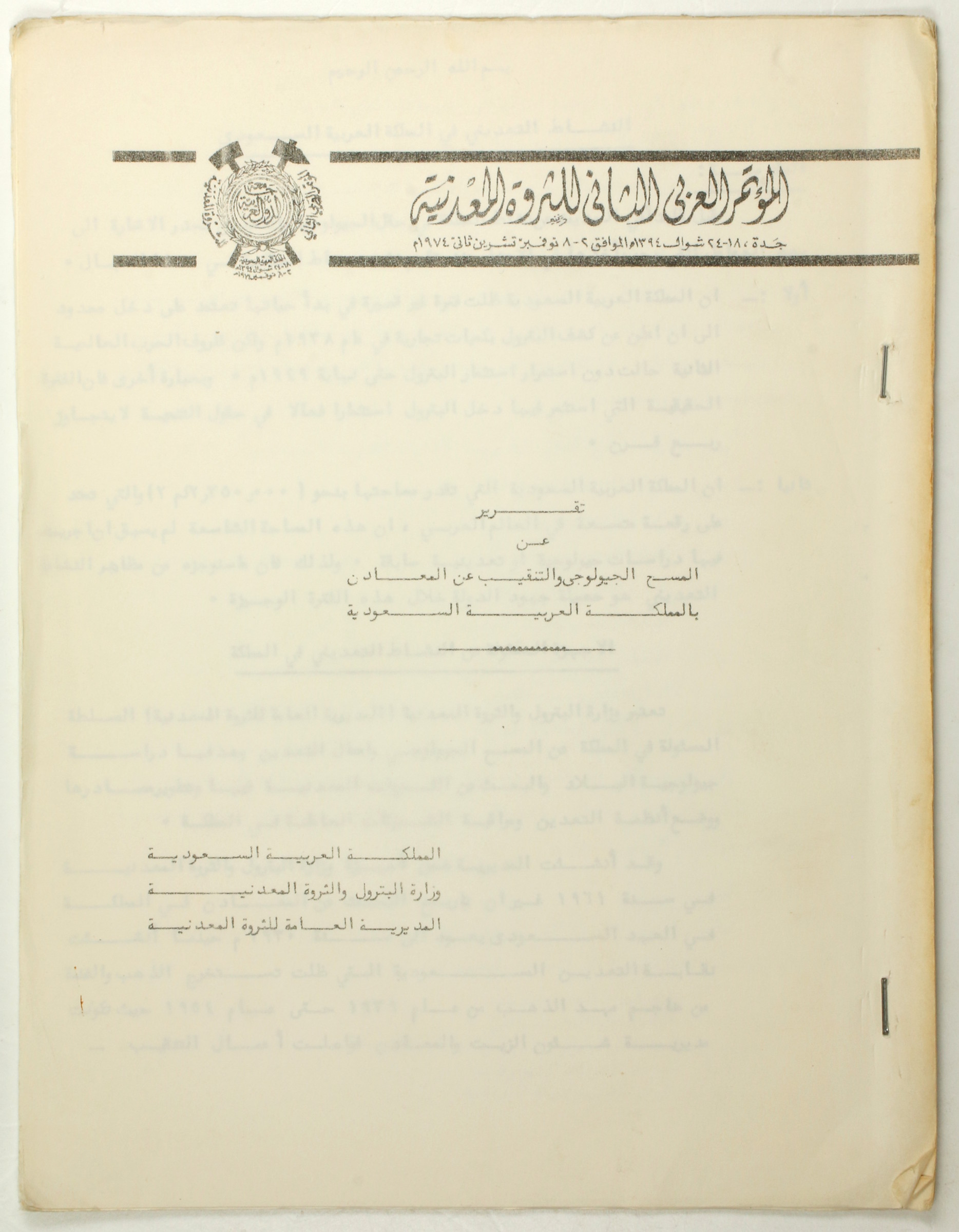
Rare governmental publication on mining activity in Saudi Arabia, presenting prospected geological survey projects. Mentions the milestone mapping programme of the 1950s and 1960s, producing the first geographico-geological maps of Saudi Arabia: the groundbreaking, fully bilingual and dual-dated series prepared by the U.S. Geological Survey and the Arabian American Oil Company under the joint sponsorship of Saudi Arabia and the U.S. State Department. Printed entirely in Arabic, including a chart on the inner lower wrapper illustrating the budget available for matters of mineral wealth.
Edges somewhat worn. Otherwise fine.

Permit of passage for Mahmoud Mohamed Mowafi, an employee of the Anglo-Egyptian Oil Wells Company, for business trips to the Red Sea Governorate, the Sidr and Assal regions, and the Sinai.
Valid through 1 April of 1958, not renewed thereafter.
Very well preserved.
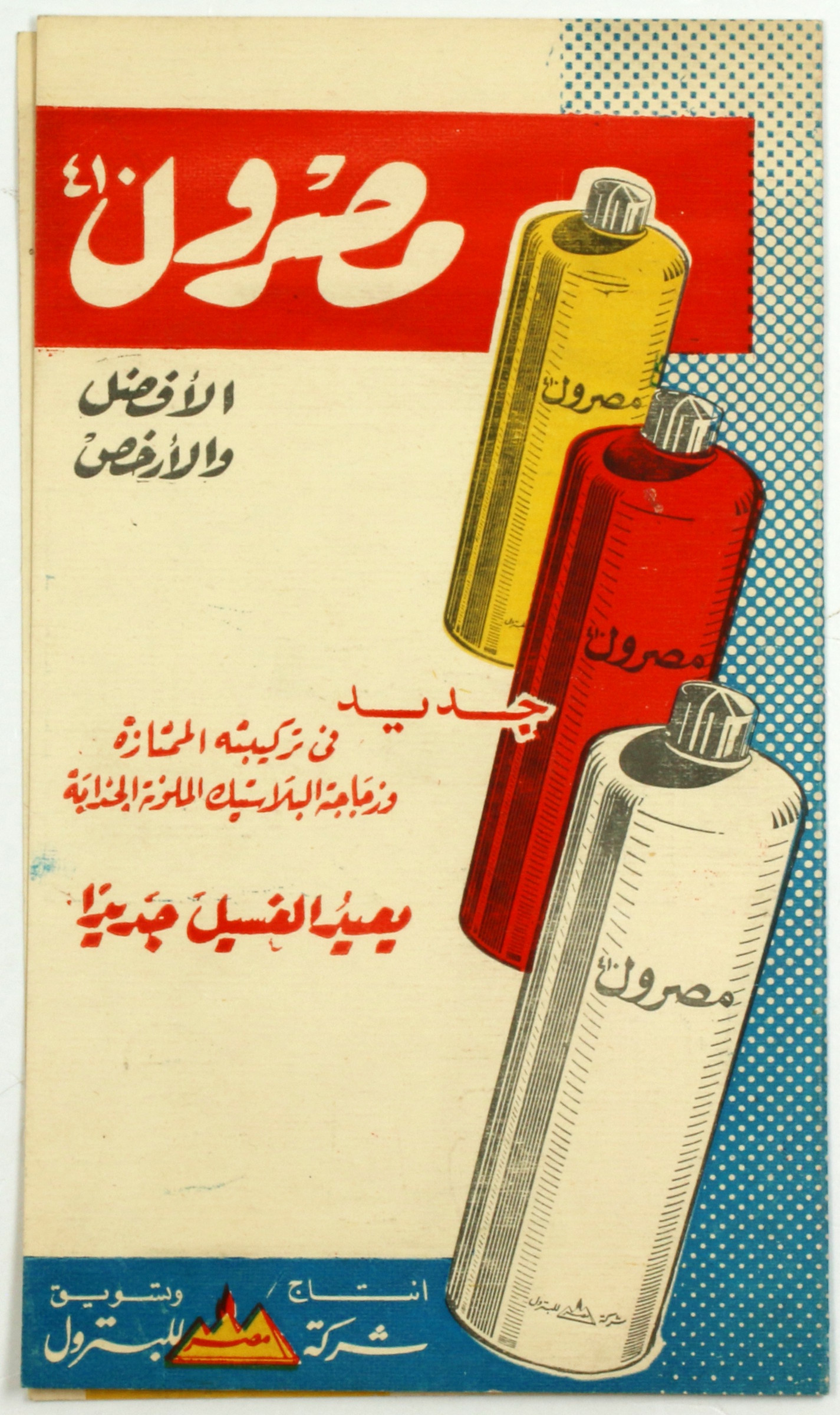
Colourful advertising brochure for a new detergent produced by Egyptian General Petroleum. It promotes the product's large scope of applicability, including laundry, dishes, glassware, carpets and even cars, not failing to point out its practical new packaging in plastic bottles.
In excellent condition.
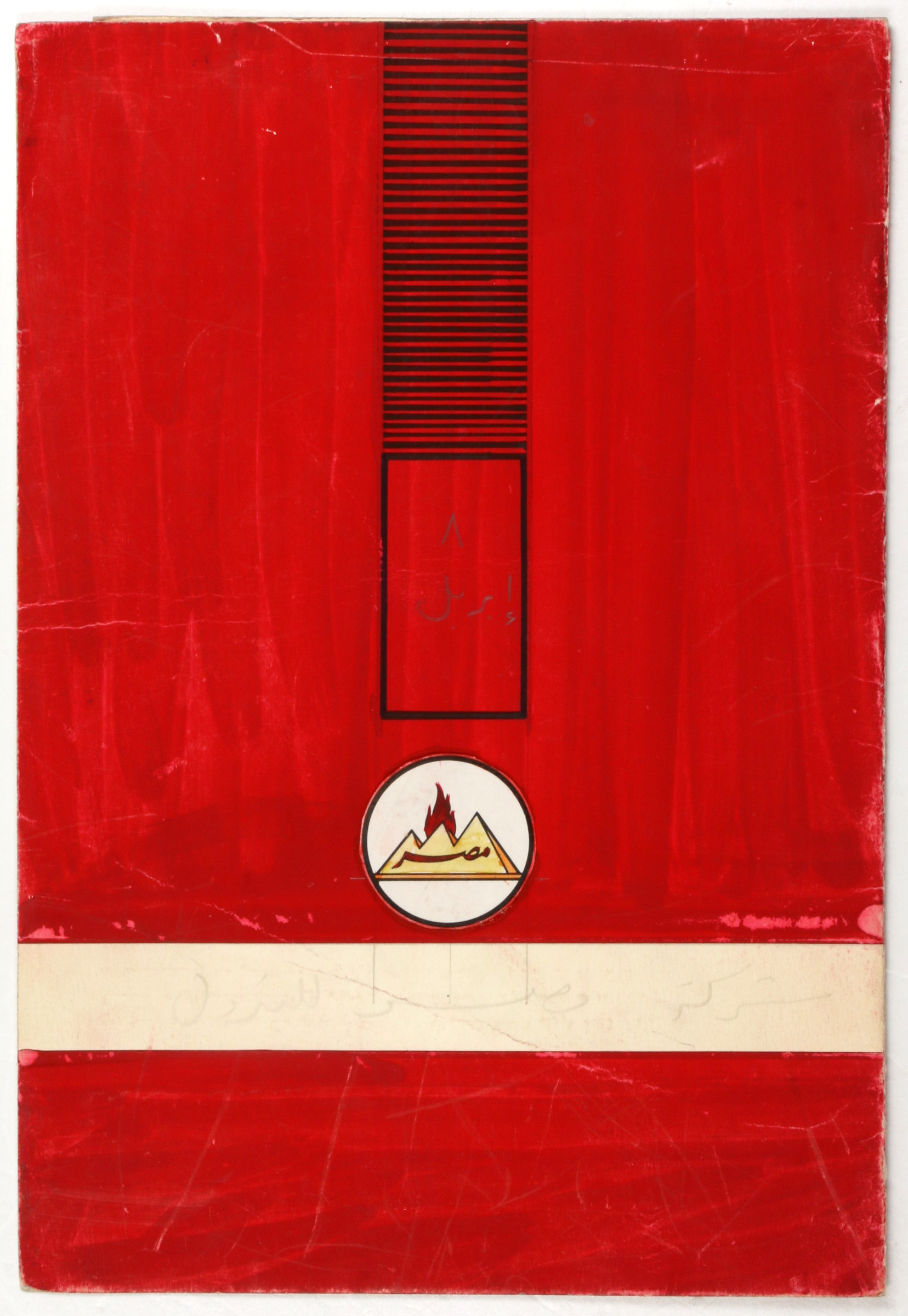
Unusual education brochure on the correct maintenance of Diesel engines, involving oil change, lubrication, the choice of fuel, and cleaning. With a sketch showing the proper way of bottling oil.
Very well preserved.
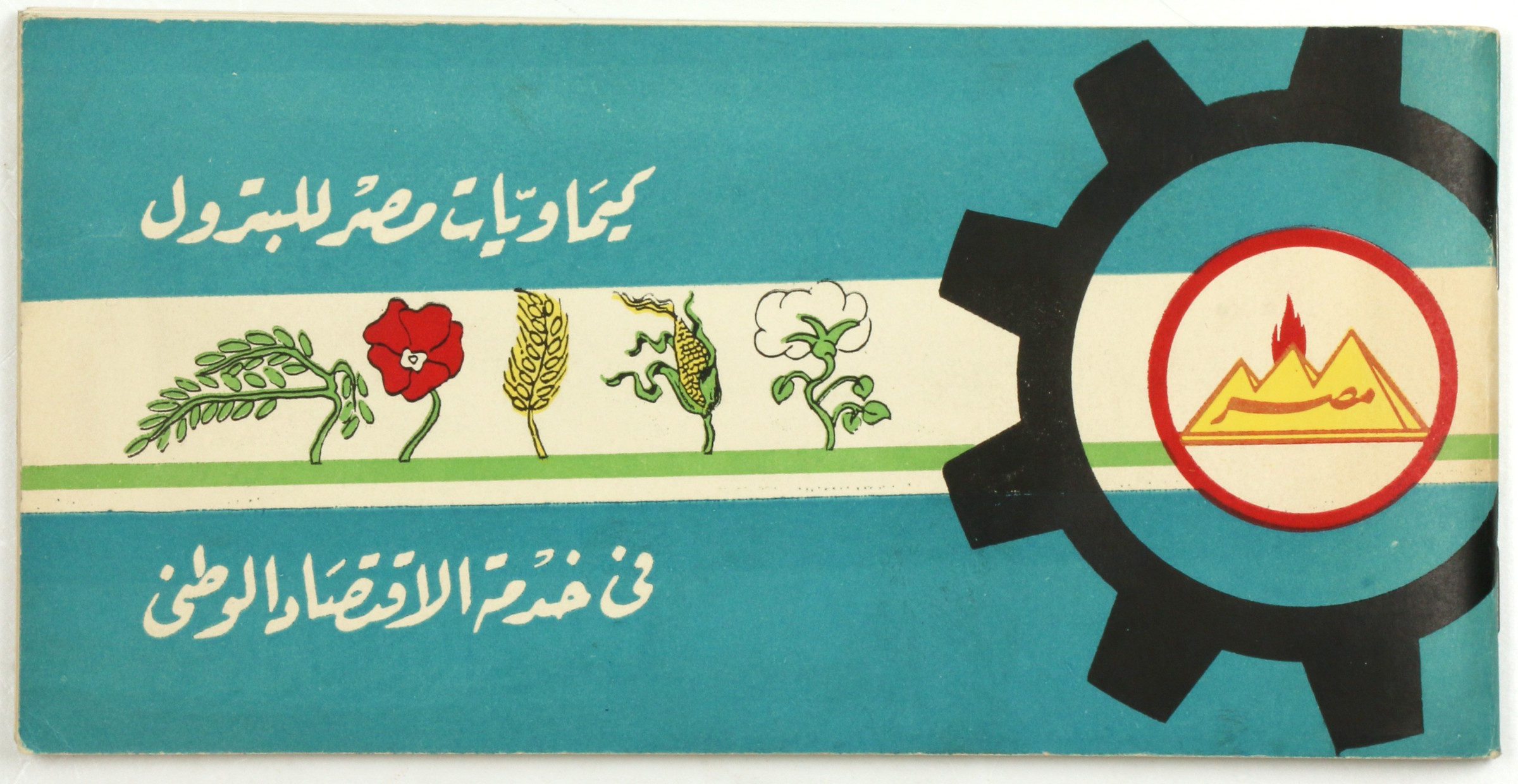
Advertising brochure for the petrochemical products of Egyptian General Petroleum. Promotes pesticides, weed killers and insecticides, pointing out how they would benefit the national agricultural production. Further, it presents the latest cleaning agents and detergents for household use, as well as solvents, and intermediates including chemicals for the production of rubber.
Very well preserved.

Advertising brochure for Super 100, a new oil grade produced by Egyptian General Petroleum. Promotes the product's viscosity, economy, and durability, describes its benefits for the engine and how it reduces fuel consumption, particularly pointing out that it is suitable for Diesel engines.
Small crease to rear wrapper near lower right corner. Otherwise very well preserved.
















